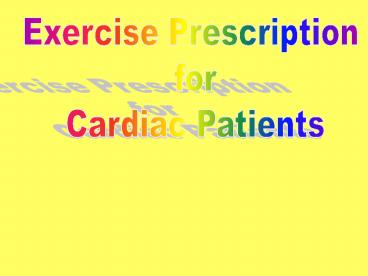Exercise Prescription - PowerPoint PPT Presentation
1 / 22
Title:
Exercise Prescription
Description:
Exercise Prescription – PowerPoint PPT presentation
Number of Views:135
Avg rating:3.0/5.0
Title: Exercise Prescription
1
Exercise Prescription for Cardiac Patients
2
Inpatient Programs
3
Benefits
- Risk Factor Modification
- Activity Counseling
- Patient and Family Education
4
Major Components of Cardiac Rehab
- Assessment of functional tolerance to activities
of daily living - Emphasis on patient counseling and Education
5
Activities during the first 48 hr. following MI
or Cardiac Surgery
- Self Care Activities
- Arm and leg range of motion movement
- Low Resistance activities
6
Optimal Dosage of Exercise Depends on
- Medical History
- Clinical Status
- Symptoms
- Patients should not have ischemia during exercise
7
- Intensity
- RPE less than 13
- To tolerance of asympotamic
- Duration
- Intermittent bouts of 3-5 min.
- Rest periods shorter than exercise bout
- 20 Min total duration
8
- Frequency
- 1-3 days after the surgery, exercise 3-4 times
per day - On day 3, exercise 2 times per day
- Progression
- Increase to 10-15 min of continuous exercise,
then increase intensity
9
Goal Exercise Capacity of 4-5 METS by
hospital discharge.
10
Before Discharge, Patient should have knowledge
of
- Activities that are inappropriate or excessive
- a safe progressive plan of exercise
- optimal risk reduction
11
Outpatient Programs
12
Goals of Outpatient Program
- Provide appropriate patient supervision to ensure
detection of problems. - Return patient to pre-morbid vocational and/or
recreational activities. - Develop and help patient implement safe and
effective home exercise program and lifestyle. - Provide patient and family education.
13
Some Signs and Symptoms..
- Onset of angina or other symptoms
- Plateau or decrease in systolic blood pressure
Systolic gt240mmHg Diastolic gt110mmH - Radionuclide evidence of LV dysfunction
- Increased frequency of ventricular arrhythmias
- Significant ECG disturbances (2 or 3 degree AV
block, atrial fibrillation, etc.) - Other signs/symptoms of intolerance to exercise
14
Determining Amount of Exercise
- Plot the exercise test data to determine
relationships between VO2, HR, and RPE - Know when myocardial ischemia occurs during
exercise so patient can exercise below the
anginal or ischemic threshold - Peak exercise HR 10 bpm below the threshold is
appropriate - Consider medication effects and characteristics
that place patient at risk
15
Outpatient Rate of Progression
- Increase in exercise every 1 to 3 weeks
- Goal of achieving 20 to 30 minutes of continuous
exercise before progressing intensity - Those with PVD should aim for 10 to 15 min.
continuous ex.
- Goal of 5 METS at hospital discharge
- For those with lower exercise capacity, use
intermittent exercise programs
16
Types Of Outpatient Programs
- Goal Progression toward an independent
self-managed program - Some patients may need to stay in a clinically
supervised program - Most patients should participate in a clinically
supervised program at least 3 months - Phase 2 and Phase 3 programs
17
Guidelines for Progression to Independent
Exercise
- Functional Capacity 8 Mets or greater
- Appropriate hemo- dynamic response to exercise
- Appropriate ECG response at peak exercise
- Cardiac symptoms stable or absent
- Adequate management of risk factor intervention
strategy and safe exercise participation - Demonstrated know-ledge of the disease process,
signs, etc. - Demonstrated compliance
18
Resistance Training
- May not be appropriate for those
with Congestive Heart Failure Severe
Valvular Disease Uncontrolled
Arrhythmias significant left ventricular
dysfunction
19
When should you use resistance training?
- Start 4-6 weeks into supervised cardiorespiratory
endurance exercise program
- Use elastic bands, light handweights, or
resistive tubing to add variety - Monitor heart rate and ECG continually
20
Exercise Endpoints
- Rate Pressure Product should not exceed that
during prescribed endurance exercise or that
achieved during a Graded Exercise Test - Endpoints should be consistent with those
outlined in ACSM Guidelines (p.97) for
termination of a GXT
21
Indications for Resistance Training for
Outpatients
- Four to six weeks after Myocardial infarction
- One to two weeks following PTCA or other
revascularization procedure without MI
- Four to six weeks in supervised aerobic program
or completion of phase II - Diastolic blood pressure lt105mmHg
- Peak exercise capacity of gt 5 METS
22
Special considerations
- CABG or valvular surgery
- PTCA, MI, or angina
- Silent ischemia
- Severe LV dysfunction and CHF
- Pacemakers
- Heart transplant































